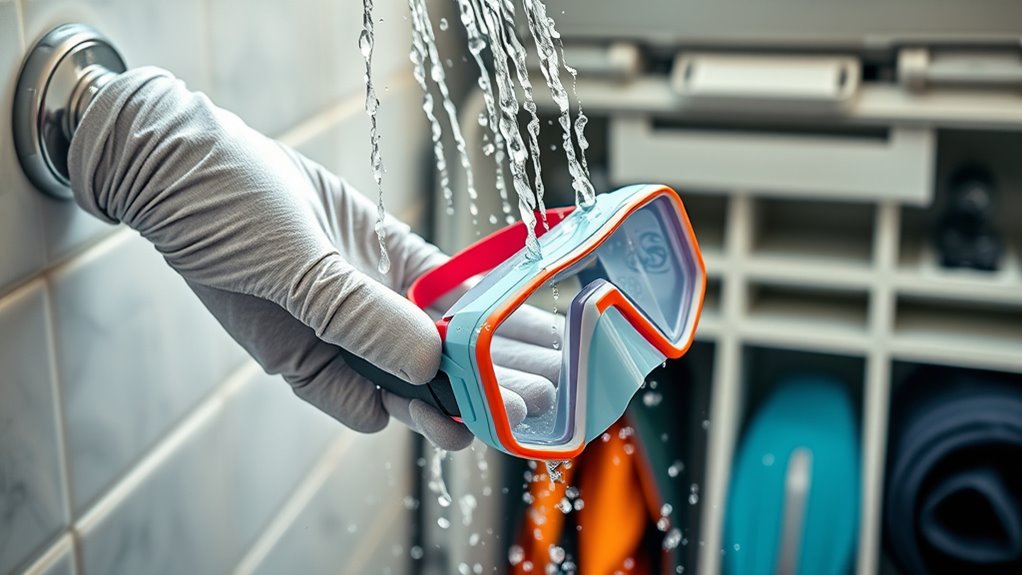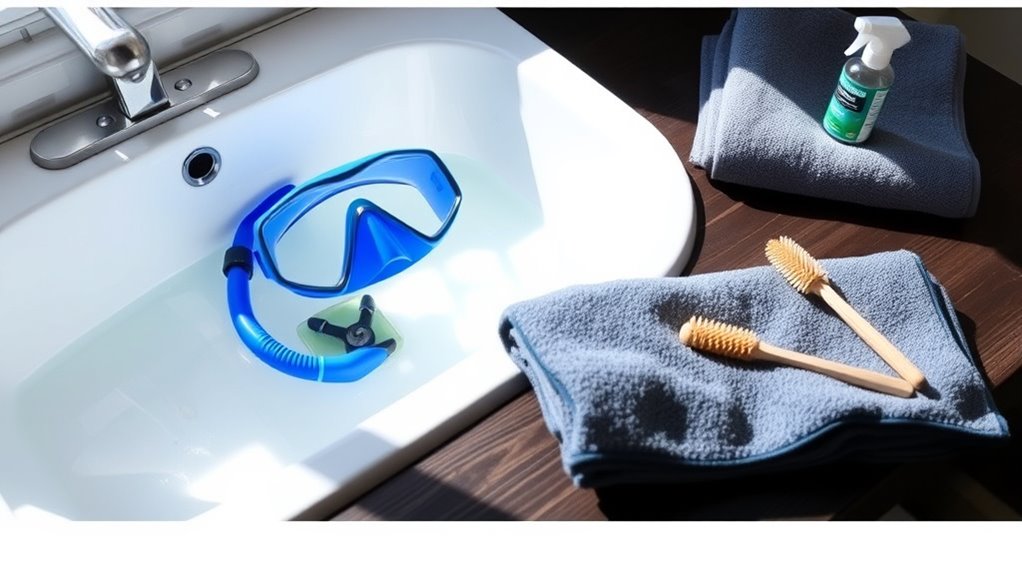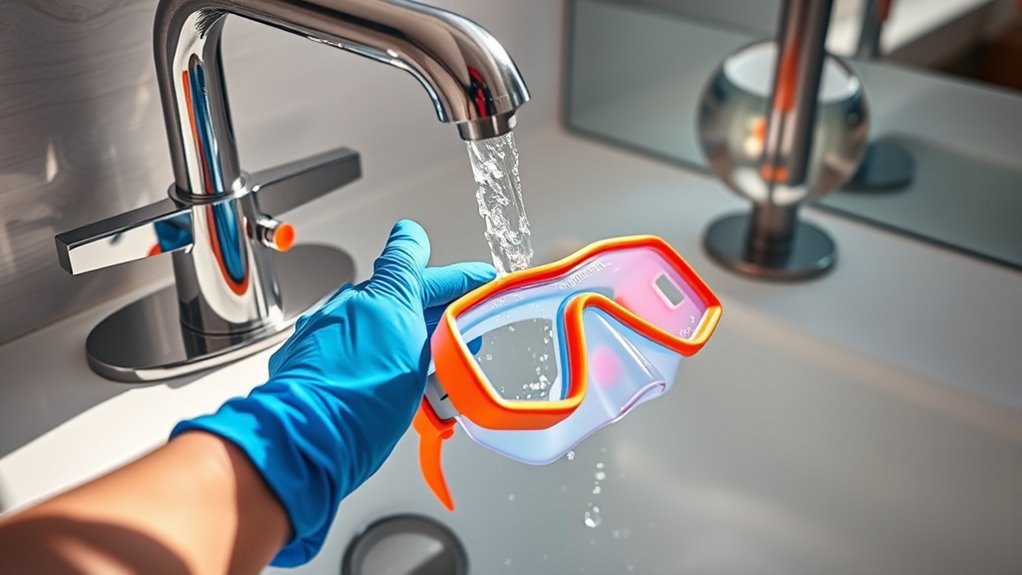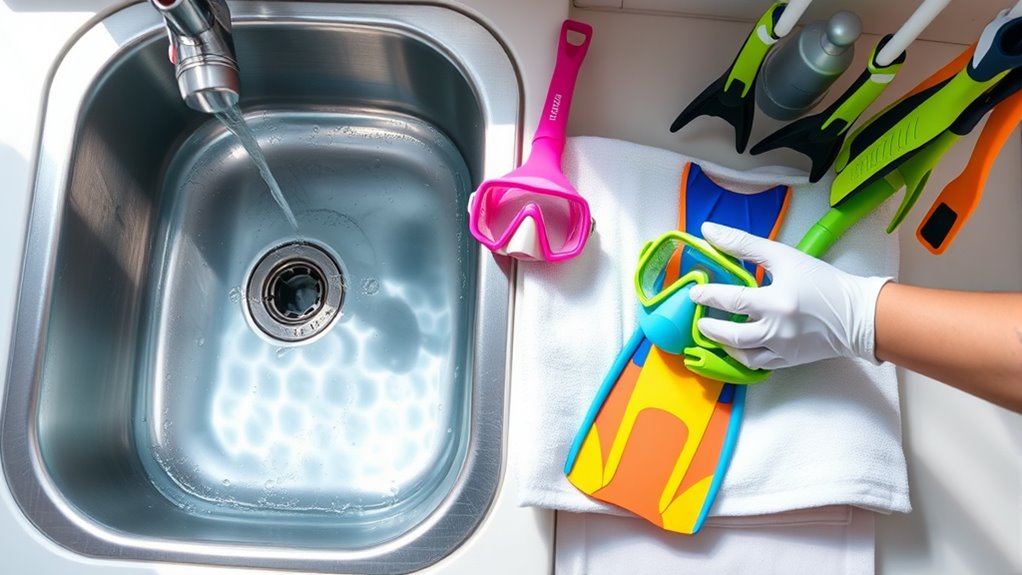After saltwater use, rinse your gear thoroughly with fresh water, paying attention to crevices and salt deposits. Clean and disinfect your snorkel and mask with mild cleaners, then dry them completely in a well-ventilated area away from sunlight. Check for any damage and maintain your gear regularly to guarantee safety. Store everything in a cool, dry place in breathable bags. Keep these tips in mind, and you’ll keep your gear in top shape for next adventures.
Key Takeaways
- Rinse all snorkel gear thoroughly with fresh water immediately after saltwater use, focusing on crevices and salt deposits.
- Disinfect masks and snorkels by soaking in warm water mixed with a gentle cleaner or vinegar solution, then scrub all surfaces.
- Shake off excess water, towel-dry equipment, and allow it to air dry in a well-ventilated, shaded area before storing.
- Inspect gear regularly for cracks, tears, or loose parts, replacing damaged components promptly to ensure safety.
- Store gear in a cool, dry, well-ventilated place away from direct sunlight, ensuring all parts are completely dry to prevent mold and deterioration.
Rinse Your Gear Thoroughly With Fresh Water

After each saltwater dive or snorkel session, ensuring to rinse your gear thoroughly with fresh water is essential. Salt residue can corrode your equipment and cause it to deteriorate faster. Hold your mask, snorkel, and fins under a gentle stream of cool, clean water, making sure to remove all salt deposits. Pay special attention to the mouthpiece and any crevices where salt can accumulate. Avoid using hot water, which might damage some materials. Instead, focus on flushing out every part, including straps and buckles. This simple step helps prevent salt buildup that can lead to mold, unpleasant odors, and material degradation. Regular rinsing keeps your gear in good condition, ready for your next underwater adventure. Additionally, understanding the importance of equipment maintenance can extend the lifespan of your snorkeling gear significantly. Proper storage practices are also crucial to prevent damage and preserve the integrity of your gear over time. Incorporating proper drying techniques after rinsing can further prevent mold and prolong the usability of your gear. Recognizing the importance of regular cleaning can also help maintain your equipment’s performance and safety.
Clean and Disinfect Your Snorkel and Mask

Once you’ve rinsed your gear thoroughly, it’s important to take the next step: cleaning and disinfecting your snorkel and mask. This process prevents bacteria buildup and keeps your equipment fresh. Submerge your mask and snorkel in a mixture of warm water and a gentle disinfectant, like diluted white vinegar or a snorkel-safe cleaner. Use a soft brush or cloth to scrub all surfaces, paying attention to the mouthpiece, straps, and inside the mask. Imagine these parts as a 3×3 grid:
| Surface | Cleaning Method | Purpose |
|---|---|---|
| Mask exterior | Soft cloth + cleaner | Remove salt and dirt |
| Mask interior | Brush + disinfectant | Eliminate bacteria |
| Snorkel mouthpiece | Rinse + scrub | Prevent germs buildup |
This ensures your gear is hygienic and ready for your next adventure. Additionally, understanding contrast ratio can help you select snorkel gear with better visibility in different water conditions.
Dry Your Equipment Completely Before Storage

To prevent mold, odors, and deterioration, you need to guarantee your snorkel gear is completely dry before storing it. Start by shaking off excess water and then gently towel-dry your equipment. For masks and snorkels, use a soft cloth to wipe away moisture from all crevices. Let your gear air dry in a well-ventilated area, avoiding direct sunlight, which can degrade materials. Make certain all parts, including straps and valves, are thoroughly dry before putting them away. If you have a drying rack, utilize it to promote airflow around your gear. Never store your equipment while damp, as residual moisture can lead to mold growth and unpleasant smells. Proper drying preserves your gear’s integrity and extends its lifespan. Additionally, understanding data privacy challenges in automated systems can help ensure your gear remains uncontaminated by external factors. Being mindful of storage conditions can further protect your equipment from environmental damage.
Check for Damage and Maintain Your Gear Regularly

Regularly inspecting your snorkel gear for signs of damage is essential to guarantee safety and performance. Check your mask, snorkel, and fins for cracks, tears, or warping. Look for loose straps or worn-out seals that might compromise your comfort or safety. Keep an eye on hinges and buckles to ensure they function smoothly.
| Gear Component | Common Damage Signs |
|---|---|
| Mask | Cracks, fogging, worn-out seals |
| Snorkel | Cracks, clogs, broken mouthpiece |
| Fins | Tears, bent blades, loose straps |
Regular maintenance prevents issues from worsening. Replace damaged parts promptly and keep everything in top shape. Staying vigilant ensures your gear performs well and keeps you safe underwater.
Store Your Snorkel Gear Properly to Prevent Damage

Proper storage of your snorkel gear helps maintain its condition and extends its lifespan. After cleaning, make sure all parts are completely dry to prevent mold and corrosion. Store your snorkel, mask, and fins in a cool, dry place away from direct sunlight, which can degrade materials over time. Keep gear in a breathable bag or a dedicated storage container to allow airflow and avoid moisture buildup. Avoid placing heavy objects on top of your gear to prevent warping or crushing. Ensure straps and buckles are relaxed to maintain their elasticity. Regularly inspect stored equipment for any signs of damage or wear, and address issues promptly. Additionally, understanding material degradation can help you choose the best storage practices to prevent deterioration. Incorporating mindfulness in your storage routine can help you stay attentive to potential issues and prolong your gear’s lifespan. Proper storage not only preserves your gear but also ensures it’s ready for your next adventure. For optimal longevity, consider preventing environmental damage through appropriate storage techniques.
Tips for Long-Term Care and Maintenance

Long-term care for your snorkel gear requires consistent attention to keep it in top shape. Regularly inspect your equipment for signs of wear or damage, replacing parts as needed. Rinse all gear thoroughly with fresh water after each use, especially saltwater, to prevent corrosion and buildup. Store your gear in a cool, dry place away from direct sunlight, which can degrade materials over time. Periodically clean masks and snorkels with mild soap and a soft brush to remove residue. Check your straps and seals for elasticity and cracks, replacing them if necessary. Lubricate moving parts, like mouthpieces, with silicone grease to maintain flexibility. Incorporating AI-driven diagnostics can help identify potential issues early, extending your gear’s lifespan and ensuring safe, enjoyable snorkeling adventures. Additionally, understanding the cultural narratives promoted through film and media can inspire new ways to explore the ocean environment and protect marine life. Staying informed about advanced maintenance techniques can further enhance your equipment’s longevity and performance. Regular maintenance of your gear can also help preserve its performance quality, ensuring optimal function during your dives. Moreover, consulting expert advice can provide personalized tips to optimize your gear care routine and troubleshoot specific issues.
Frequently Asked Questions
How Often Should I Replace My Snorkel Gear Due to Wear?
You should replace your snorkel gear when you notice signs of wear, such as cracked or brittle mouthpieces, damaged hoses, or foggy masks that won’t clear. Typically, gear lasts 1 to 3 years with regular use, but saltwater can accelerate deterioration. Regular inspections help. If you see significant deterioration, it’s best to replace your gear to guarantee safety and peak performance during your snorkeling adventures.
Can I Use Bleach to Disinfect My Snorkel Equipment?
Sure, you can use bleach to disinfect your snorkel gear, but you need to be careful. Dilute a small amount of bleach in water—about one part bleach to 10 parts water—and soak your gear briefly. Rinse thoroughly with fresh water afterward to remove any residual chemicals. This helps kill bacteria and bacteria without damaging your gear, ensuring safe and sanitized snorkeling adventures every time.
What Are Signs of Salt Water Corrosion on My Gear?
You should check for signs of saltwater corrosion on your gear, like rust spots, discoloration, or a crusty buildup on metal parts. If you notice any pitting or roughness, it’s a sign corrosion is setting in. Also, look for cracking or loss of integrity in plastic or silicone components. Regular cleaning and proper storage help prevent these issues, keeping your gear in top shape for your next adventure.
Is It Safe to Store Snorkel Gear in a Humid Environment?
Think of your gear as a delicate garden that needs proper care. Storing your snorkel gear in a humid environment isn’t ideal; it’s like watering your plants with a hose full of salt. Humidity encourages mold and corrosion, which can damage your equipment over time. To keep your gear in top shape, store it in a cool, dry place, and make sure it’s thoroughly dried before putting it away.
How Do I Prevent Fogging in My Mask During Snorkeling?
To prevent fogging in your snorkel mask, you should apply a defogging solution or a small amount of baby shampoo inside the lens before each use. Rinse it lightly with water and make certain it’s dry before snorkeling. Breath out gently onto the inside of the mask if fog starts to form, and consider using an anti-fog spray for longer-lasting clarity. These tips keep your view clear and enhance your snorkeling experience.
Conclusion
By taking these simple steps, you’ll keep your snorkel gear in top shape, ready for your next underwater adventure. Think of your gear as a delicate garden—regular care and proper storage help it flourish season after season. With a little effort, your equipment will resist damage like a sturdy ship weathering storms, ensuring you enjoy many more underwater explorations without worry. Keep your gear well-maintained, and the ocean will always be at your fingertips.










